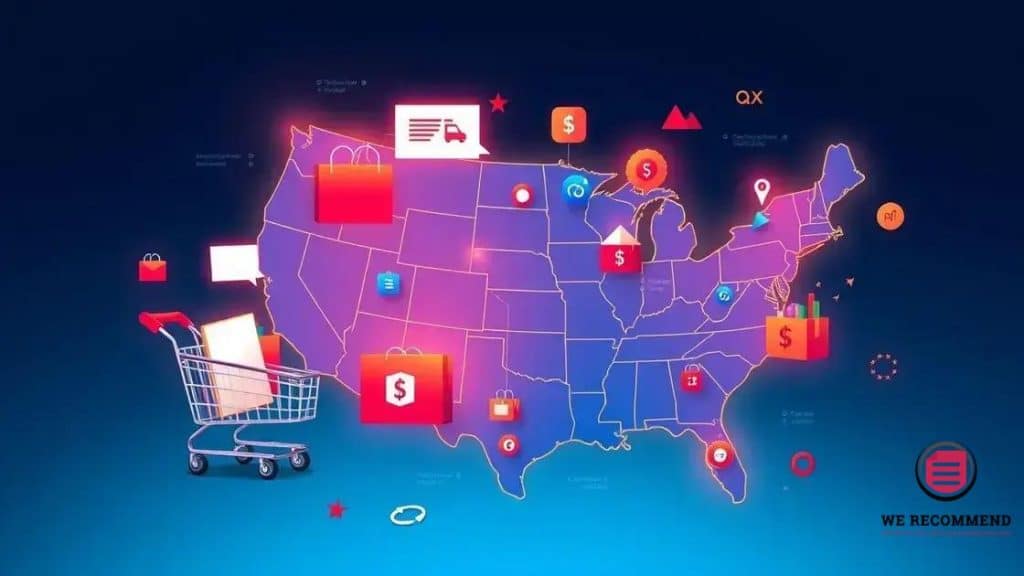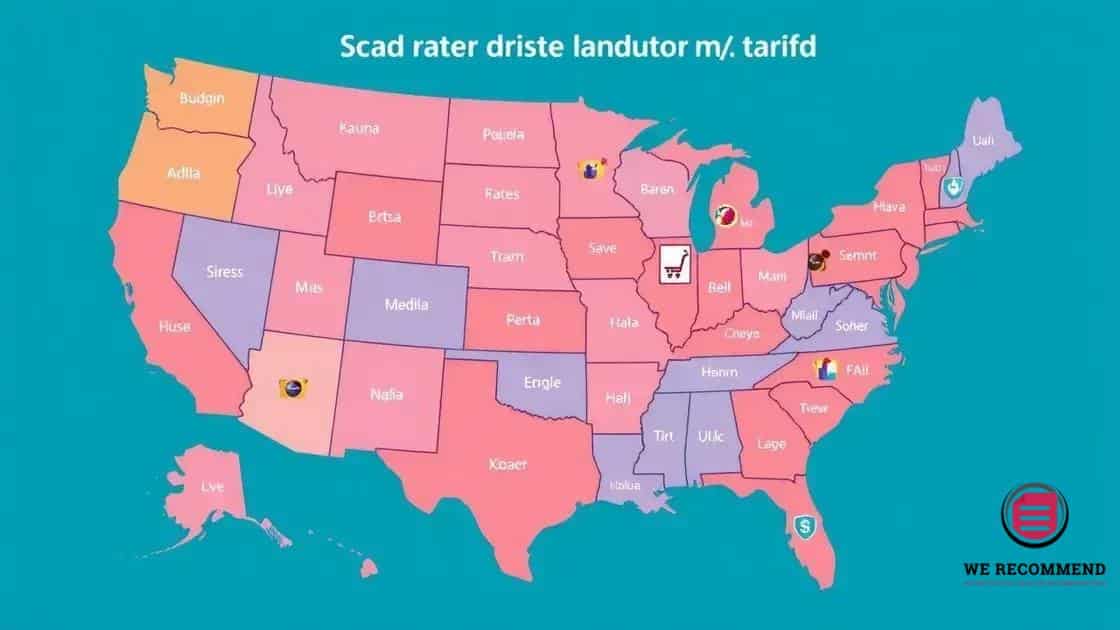E-commerce tariffs impact USA: what’s at stake?

Anúncios
E-commerce tariffs impact consumer prices and business strategies, necessitating awareness and adaptation to avoid higher costs and ensure competitiveness.
E-commerce tariffs impact USA consumers in significant ways. Have you ever wondered how these tariffs influence what you pay for products online? Let’s dive into the details and explore the effects together.
Anúncios
Understanding e-commerce tariffs
Understanding e-commerce tariffs is essential for both consumers and businesses in the USA. These tariffs are taxes imposed on goods imported from other countries that can significantly affect pricing.
Anúncios
By raising tariffs on specific products, the government aims to protect local industries. However, this can lead to higher prices for consumers buying imported goods.
The Role of Tariffs
Tariffs can influence online shopping habits. When prices rise, consumers might reconsider their purchases, potentially opting for domestic products or waiting for sales.
For businesses, managing these tariffs is critical to remain competitive. Here are some impacts of tariffs:
- Increased Costs: Businesses may face higher costs, which could be passed on to consumers.
- Changing Supply Chains: Companies might need to source products from different countries to avoid high tariffs.
- Market Adjustments: Consumers may shift their purchasing patterns based on tariff impacts.
How tariffs shape online shopping behavior
Today, tariffs play a significant role in shaping how consumers shop online. With import duties affecting prices, many people are considering alternatives.
When tariffs increase on certain goods, shoppers may decide to look domestically or postpone their purchases.
Impact on Consumer Choices
Tariffs can lead to a change in buying behavior, as consumers adjust to price fluctuations. For instance:
- Price Sensitivity: Higher prices may push consumers to seek out cheaper alternatives or wait for sales.
- Brand Loyalty: Some customers might switch brands if they perceive better value elsewhere.
- Product Awareness: Consumers might become more aware of domestic products due to tariffs, choosing local over foreign items.
As a result, understanding these shifts can help businesses adjust their strategies to meet new demands.
It’s important for businesses to stay ahead and adapt to the changing landscape caused by tariffs. For more details, check out this resource on trade and tariffs.
The economic impact on USA businesses
The economic impact of tariffs on USA businesses is profound and multifaceted. When tariffs increase, companies often face higher operational costs.
This situation can affect both large corporations and small businesses, with many needing to adjust their pricing strategies.
Effects on Pricing and Profit Margins
As tariffs raise the cost of imported goods, businesses may be forced to raise their prices to maintain profit margins. This can lead to:
- Reduced Consumer Demand: Higher prices may discourage consumers from making purchases.
- Pressure on Profitability: Businesses might see a squeeze on their profits, impacting investments and growth.
- Supply Chain Adjustments: Companies may need to find new suppliers or alter their logistics to minimize tariff impacts.
Understanding these economic effects is crucial for businesses to adapt and remain competitive in the market. For further insights, visit the Small Business Administration.
Regional variations in e-commerce tariffs

Regional variations in e-commerce tariffs can significantly influence online shopping experiences across the USA. Different states may implement various tariffs that affect product pricing.
These discrepancies can lead to challenges for both consumers and businesses, as consumers may face differing prices for the same products based solely on their location.
Understanding Regional Differences
Factors contributing to the variations in tariffs include:
- State Legislation: Each state has the power to set its own tariff rates, which can lead to inconsistencies.
- Type of Products: Certain goods may be taxed differently based on their classification, impacting regions based on local demand.
- Online vs. In-Store: Some areas might have lower tariffs for e-commerce purchases compared to traditional retail.
Consumer awareness of these regional tariff differences can help them make more informed shopping decisions. For more detailed insights on tariffs, consider visiting the U.S. Census Bureau.
Consumer perceptions of tariffs
Consumer perceptions of tariffs can greatly influence shopping behavior and attitudes toward products. Many shoppers are unaware of how tariffs affect the prices they pay for goods.
Tariffs can create confusion, leading to mixed feelings about purchasing imported products due to perceived value or ethical considerations.
Factors Influencing Consumer Views
Several factors shape how consumers perceive tariffs:
- Abrupt Price Changes: Sudden increases in product costs due to tariffs can frustrate customers.
- Awareness Campaigns: Education about what tariffs are and how they impact prices can shift consumer perspectives.
- Brand Loyalty: Consumers may prefer to support local brands over foreign ones if they feel tariffs protect local jobs.
Understanding these perceptions can help businesses tailor their marketing strategies. For more information on consumer behavior, visit the American Bankers Association.
Strategies for businesses to adapt
Businesses face many challenges due to e-commerce tariffs. To remain competitive, it’s essential to adopt effective strategies for adaptation. By understanding the market dynamics, companies can navigate these changes successfully.
One effective approach is to thoroughly review supply chains. This involves identifying potential suppliers that might offer better pricing or alternative products.
Key Strategies for Adaptation
Consider implementing the following strategies to adapt:
- Diversifying Suppliers: Work with different suppliers across various regions to minimize tariff impacts.
- Strategic Pricing: Adjust pricing strategies to accommodate increased costs, ensuring competitive pricing while maintaining margins.
- Enhancing Marketing Efforts: Educate consumers about the value of your products despite tariff-induced price changes.
Businesses should stay informed about tariff regulations and trends to make proactive decisions. For more insights on adaptation strategies, visit the Small Business Administration.
Future trends in e-commerce tariffs
As e-commerce continues to evolve, understanding future trends in e-commerce tariffs is essential for businesses and consumers alike. Tariffs can change based on political, economic, and technological developments.
These changes affect online shopping experiences and how products are priced. Staying ahead of these trends can help companies make informed decisions.
Emerging Trends to Watch
Some key trends expected to shape the future of e-commerce tariffs include:
- Increased Integration of Technology: Automation and data analytics may lead to more efficient tariff processes, reducing costs for businesses.
- Shifts in Trade Policies: Changes in government policy can lead to fluctuating tariffs, impacting how businesses strategize their supply chains.
- Greater Consumer Awareness: As shoppers become more informed about tariffs, they may demand transparency in pricing, affecting how companies communicate their value.
Businesses must remain proactive to navigate these evolving tariff landscapes effectively. For more detailed insights on trade policies, visit the International Trade Administration.
Navigating the tariff landscape: tips for consumers

Navigating the tariff landscape can be challenging for consumers, as it affects online shopping experiences and product prices. Understanding how to deal with tariffs can help you save money and make informed choices.
Being aware of the potential impacts of tariffs on your purchases is essential in today’s e-commerce environment.
Tips for Consumers
Here are some helpful tips to navigate the tariff landscape:
- Research Tariff Rates: Before making purchases, check tariff rates on products to understand potential added costs.
- Buy Domestic: Consider purchasing products from local businesses or manufacturers to avoid high import tariffs.
- Stay Informed: Follow news on trade policies and tariffs, as these can change and affect pricing.
Taking these steps can help consumers make better purchasing decisions. For more information on tariffs and their implications, visit the International Trade Administration.
In conclusion, understanding e-commerce tariffs is essential for consumers and businesses
The impact of tariffs on pricing, shopping behavior, and overall market dynamics cannot be underestimated. By staying informed about tariff rates and trends, consumers can make better purchasing decisions.
Businesses, on the other hand, must adapt to these changes to maintain competitiveness and meet consumer needs. Strategies such as diversifying suppliers and adjusting pricing will play a critical role in navigating this complex landscape.
Ultimately, both consumers and businesses should engage with resources that provide valuable insights into tariffs and their implications, enabling them to thrive in the evolving e-commerce environment.
FAQ – Frequently Asked Questions about E-commerce Tariffs
What are e-commerce tariffs?
E-commerce tariffs are taxes imposed on goods that are imported into a country, affecting the overall cost of products sold online.
How do tariffs impact consumer prices?
Tariffs can increase the cost of imported goods, which often results in higher prices for consumers when they shop online.
What can consumers do to mitigate the effects of tariffs?
Consumers can research tariff rates, consider buying domestic products, and stay informed about trade policies to make better purchasing decisions.
How can businesses adapt to changing tariffs?
Businesses can diversify their suppliers, adjust pricing strategies, and enhance marketing efforts to inform consumers about product value despite tariff impacts.






